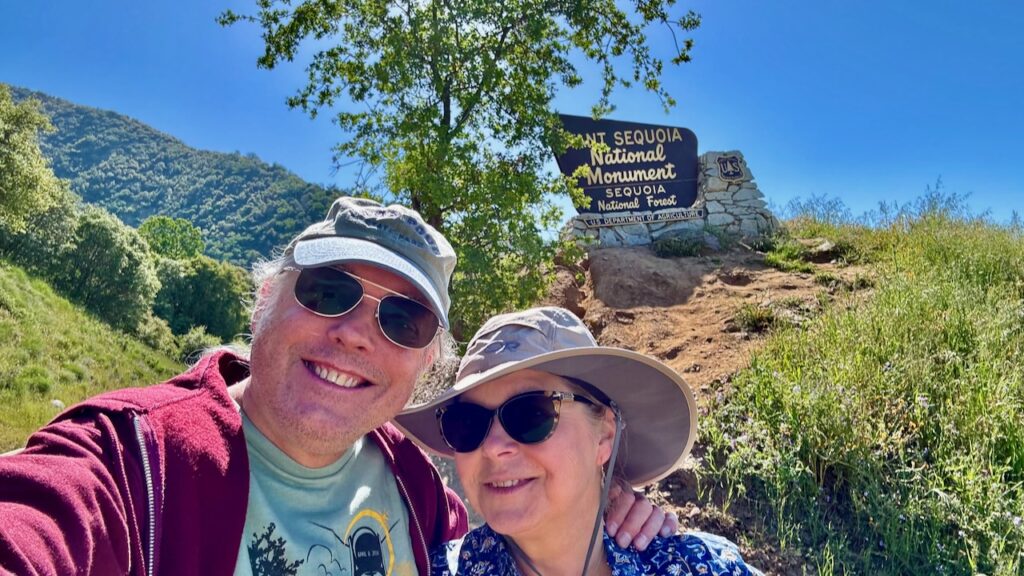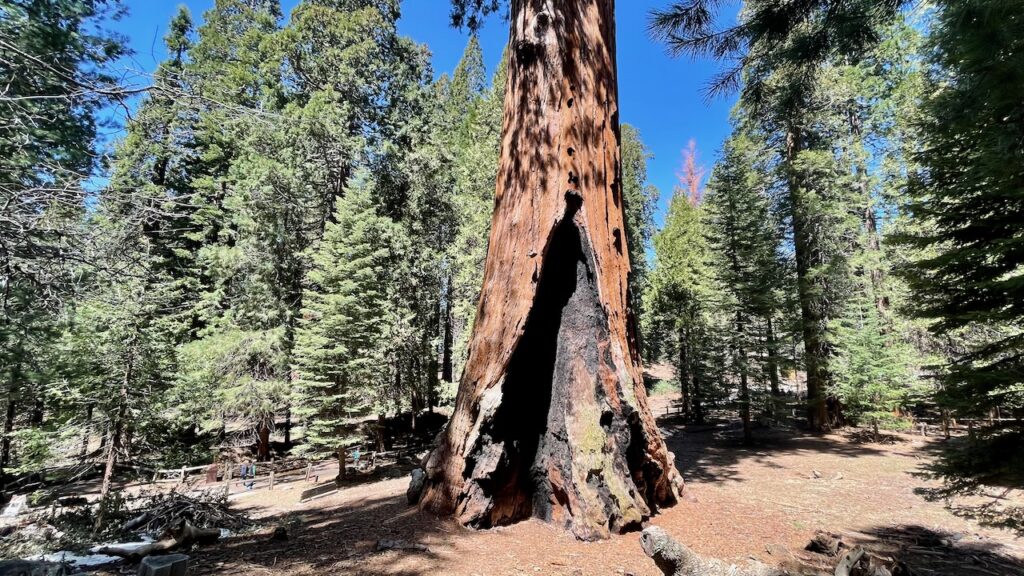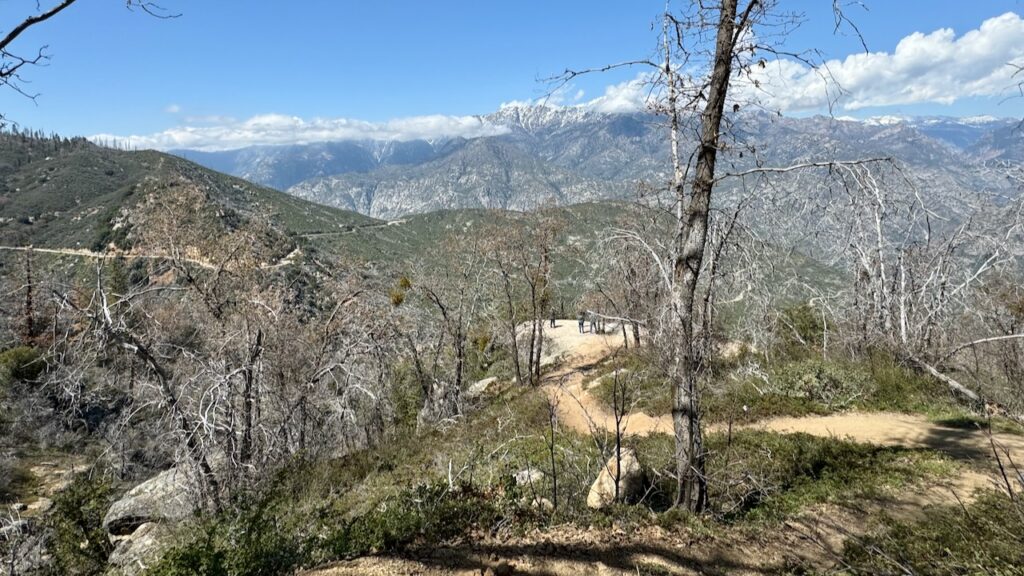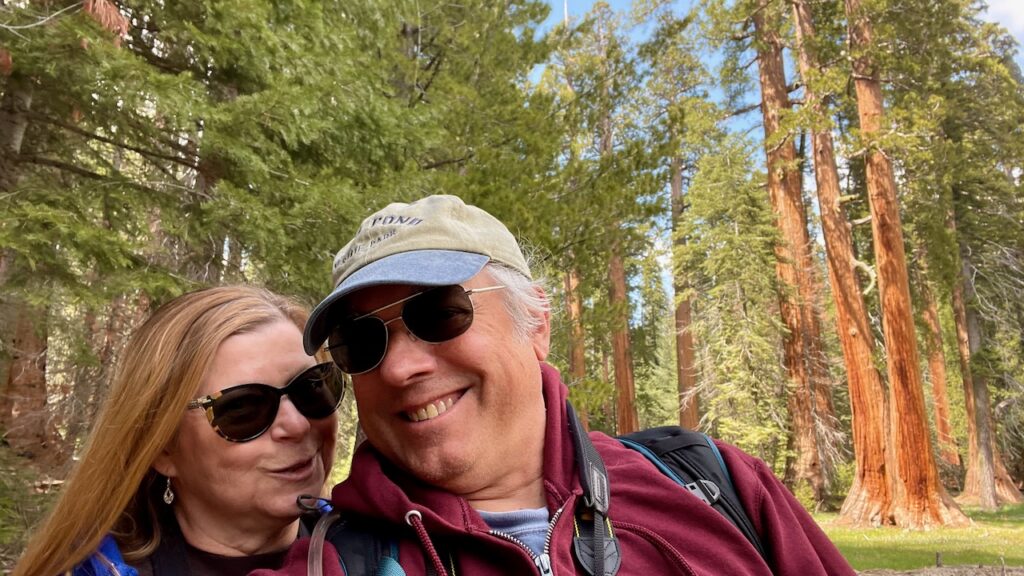Trees, Lot of Big Trees, But No Diet Coke
May 1,2 & 3 2024 – Sequoia RV Park, Dunlap California
We’ve spent 3 days at this campground exploring all that Kings Canyon National Park and Sequoia National Park have to offer. It will just be 1 giant blog entry not 3.
April 20, 2024
Bonus content! We missed a few photos from the drive to Dunlap. We passed through the little town of Visalia, CA. It was very tight driving through it but somehow we managed. We saw this fun mural as we made our way across town.

The road up from Orange Grove to the campground was very steep in places and curvy and steep in other places. We have a new low uphill score of just 21 mph (with the foot to the floor!).

May 1, 2024 – Kings Canyon National Park
As expected the ride up to the campground was steep and curvy. Driving made it appear almost flat but it belied what was ahead of us. We drove up from about 1,500 feet to 7,500 feet!

It was pretty intimidating to drive, in places you had what looked like a sheer drop offs with no guardrails.
We stopped for a photo op.

Wait, that’s not King’s Canyon National Park nor is is it Sequoia National Park, it is the Giant Sequoia National Monument. There is also a Sequoia National Forest. It just comes down to when the parcels were created and who is paying for it is our best guess. To make it even more confusing Kings Canyon National Park and Sequoia National Park both share a border with each other. Confusing things further they share a website. To complete the confusion they share an entrance station. They don’t share gift shops however. That would be weird.
We got our passport stamp for KCNP at the KCNP gift shop and chatted with a ranger nearby. See the sequoias in the parking lot?

Notice how the lower part of the trees don’t have any branches. The ranger told us that with an average snow depth of 10′ means the trees lose their lower branches (susan here: I looked it up. Ranger was wrong. The average snowfall is 18′ a year). We were impressed enough to snap the photo though. But we’re also calling shenanigans on that story for two reasons. First, you can see that the branches are missing way higher that 10’ above the ground (or even 18′). Second, most trees lose their lower branches because the tree’s upper branches and that of the neighboring tree’s upper branches shade the lower branches so they die back and fall off. But it was fun to look over at that tree and visualize the snow being that deep.
There was a short gravel path around one of the nearby sequoia groves. The trees are just as impressive as the California Redwoods we both experienced in the Muir Woods north of San Francisco back in 2016.

We eventually made it to the General Grant tree. This tree is the second largest giant sequoia on earth. President Coolidge named this tree the Nation’s Christmas Tree.
The tree is pretty impressive. Notice the burned out area on the backside of the tree. (Front and back are arbitrary of course, we’re calling the front the side that has the sign on it!) Fire is important to the sequoia’s growth. The tiny pinecones can live, green, on the tree for 20 years until the heat from the fire dries them out and they fall to the ground, now brown. The seedlings must land on open forest, the type of forest you would have after a fire. The tree itself is pretty fire resistant. You can see a white-ish patch on the left hand side of the fire scar, that is new wood that may eventually heal the scar.

Sequoias can only grow so tall because their vascular system can only pump water so high. That’s why they get the distinctive crown and snag. The snag is the dead wood at the top, the crown is the living parts of the tree that continues to grow wider.
We had lunch, Paul played radio, and then we drove around the park some more soaking in all that there was to see (susan here: and it’s a lot!). We were about 2-3 weeks too early to see all of the park (susan here: then that’s a good reason to return!) Much of the park is still closed due to snow. We had really wanted to go to Panoramic Point, a nice 500’ hike from the parking lot. But, that road was closed to vehicles and we declined the 4 mile one-way hike.
We came across one overlook with a bonus overlook down a steep hillside.

So of course Paul had to go. The view from down there was wonderful. It felt like you could see forever.

On the way home we passed a very dead section of forest. This is from a fire in the past couple of decades. It was an eerie sight in the afternoon light. The dead trees in the sunlight were silvery.

Scientists are still studying and watching out a forest recovers from fire. Since the 90s fire has killed tens of thousands of these giant sequoias.
We headed into the town of Orange Grove looking for dinner and we found some surprisingly great pizza. There was a great view of this mesa right in the middle of the fields.

We passed countless orange groves and didn’t take a picture of any of them! We did stop at a roadside self service fruit stand and bought a bag of tangerines (coffee cup for size). It was a whopping $5. Lemons were 6 for a buck. We felt that was a bit too cheap and only took 3 for the buck.

We had also did some grocery shopping in town. They were out of diet coke! Then we stopped for gas, also out of diet coke in the store. Susan was curious so she asked why everyone was out of diet coke. The clerk said, “Oh, we’ll have some Thursday. The coke truck comes every other week.” Now that’s small town!
May 2, 2024 – Sequoia National Park
Sequoia NP is at the same elevation as KCNP. But the road from one to the other goes up and down. So the little piles of snow we had been seeing were big piles of snow. We thought we had left the nasty white stuff behind!

We found the gift shop, got our passport book stamped, purchased a refrigerator magnet and set out for the General Sherman tree parking area.
There is a 1/2 mile walk to the Sherman Tree. That should be easy! Nope. You have an elevation drop of 350′ but then you gain it all on the way back. And we’re at 7,000’ of altitude that we weren’t used to. At least the path was gravel, somewhat shaded, and had several benches.

Notice the twinned trees. These are pretty common. Since the seedlings have very specific needs for germination, you often find trees growing near each other, then merging.

Here we are at the base of one of the taller twins. Notice how fuzzy the bark looks.

This is the Mark Twain tree, we can’t remember why it was cut down.

Finally, we made it to the General Sherman tree.

Up close you can see how massive this tree is.

May 3, 2024 – Sequoia National Park
We headed back to SNP the next day. Paul really wanted a quiet walk in the woods. There was a decent one at the base of the Sherman tree but it was 2.7 miles long with some (a lot) of elevation gain. Ha! So we headed back out the next day. But first, we stopped at the ranger station for the Sequoia National Monument just to get our third set of passport book stamps.
The wildflowers were in full force.

We finally remembered to stop at the scenic overlook we see on the way down, not the way up. It’s not ideal cross traffic just to get to an overlook. However, this one was worth it.

Both today and the previous day we’ve been stopped by tree work, they use really big equipment. They are taking out diseased trees. There is a bad beetle in the woods killing a lot of trees. So they’re removing them. They’ll also take out trees that are a danger to people.


We found a nice baby trail, 1/2 mile loop around a meadow. It was a really nice walk. Not very many people and lots of birds to watch.



This one tree is growing around this giant rock!

Even things that can live for 3000 years eventually die. Then they fall down, often shattering when they hit the ground. We saw evidence of this a few times. They also leave huge stumps.

Final tree picture. This tree was so damaged by fire you can see right through it to another sequoia behind it. And yes, the tree was alive.

It was a very pleasant 3 days, we plan on coming back, next time a bit later in the year when more parts of the park are open. And maybe we’ll have spent enough time at altitude to be able to tackle the bigger hikes in the woods.
Life Birds: 5 (Stellar’s Jay, Mountain Chickadee, California Scrub-Jay, Sooty Grouse, MacGillivray’s Warbler)

